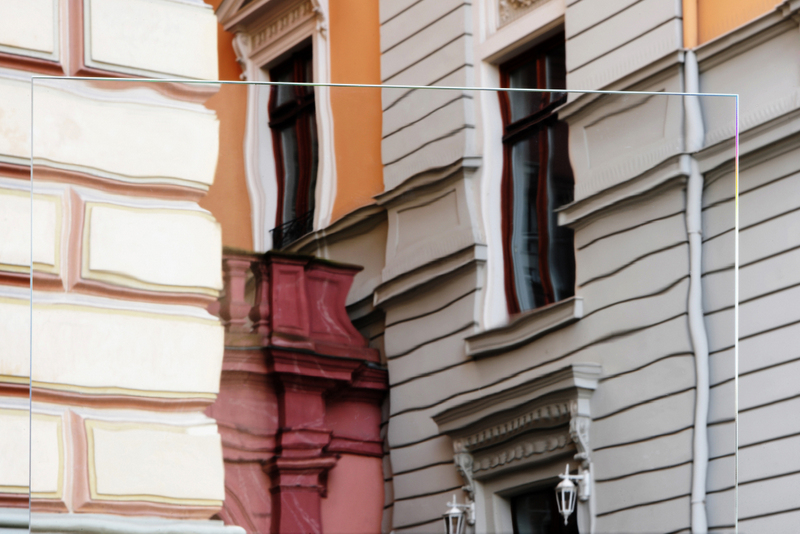
Schott authentic manufactured glass for restoration of buildings
Machine-drawn restoration glasses from Schott*
*Ulrich Huber, Sales Manager for Architectural Glasses at Schott Advanced Optics, will be giving a presentation on this topic at the ‘Denkmal und Energie’ event to be held in Osnabrück, Germany, on December 8.
Tikana®, Restover®, and Goetheglas manufactured by Schott using the authentic Fourcault process
The process is used to create various architectural glasses for the restoration of historic buildings by achieving an appearance that closely resembles the period in which the respective buildings were actually built.
The restoration glasses that Schott offers have also received European technical certification and therefore meet the demands of monument conservationists as well as building ownersand users.
About the Fourcault process
When you look through restoration glasses such as RESTOVER® plus from Schott, the even edges behind them look wavy. Photo: Schott
Fourcault process uses molten glass that is mechanically drawn upwards between several pairs of rollers on different floors of the building and then slowly cools them down. The continuous glass ribbon is finally cut into individual sheets at the top of the drawing shaft.
Ulrich Huber, Sales Manager for Architectural Glasses at Schott Advanced Optics: The special characteristics of the restoration glasses are achieved by using this historically authentic production process.The typical impression of a machine-drawn glass is characterized by deviations in terms of its thickness and flatness. Melting-related traits such as bubbles, nodes and stones within certain tolerances also contribute to the characteristic look of machine-drawn glasses. At the same time, all of the characteristics of glass can be influenced during the production process and be made to closely match the appearance of the original historic glass.
Glasses that are manufactured using the Fourcault process differ from the float glasses that are used today mainly in terms of how they can be looked through and their outer appearance. When you look through machine-drawn restoration glasses, the even edges behind them look wavy. Floated glasses on the other hand leave an undistorted impression. When you look at the surface of a machine-drawn restoration glass, you will see unevenness, while a floated glass looks flat.
All Schott restoration glasses can be processed into insulating glass, laminated glass or safety glass.
Renovating the Van de Velde building at Bauhaus University
Thanks to the insulating glass TIKANA®, the external appearance of the Van de Velde building at Bauhaus University in Weimar now resembles the aesthetics of the period in which it was used by the State Bauhaus in Weimar. Photo: Schott.
When it came to renovating the Van de Velde building at Bauhaus University in Weimar, insulating glass that consisted of an outer pane of Tikana glass was used. The external appearance of the building now resembles the aesthetics of the period in which it was used by the State Bauhaus in Weimar.
Tikana was particularly well suited for this project because its slightly uneven surface fits in harmoniously with the buildings of the classical modern period. Besides its standard thickness of 4 mm, this glass can also be manufactured in 6 mm thickness and in lengths of up to 3,000 mm.
In addition to Tikana glass, the restoration glass Restover is also manufactured using the Fourcault process.
Restover Glass
It resembles the window glass manufactured around the turn of the century. Thanks to its relative thinness, it can easily be installed in historic window frames and profiles. With Restover light, a more lightly structured surface version that resembles mouth-blown glass is now also available. Restover plus, on the other hand, has a more dominant structure.
Goetheglas
This is another restoration glass from Schott – a colorless, drawn glass with an irregular surface full of character that was used predominantly in the 18th and 19th century. It is also suited for use as outdoor glazing, for instance to protect precious lead glazings from environmental and weather damages.
Architectural glasses
Schott product line includes not only machine-drawn restoration glasses, but also several high-quality architectural glasses:
- decorative clear glass Artista® for indoor and outdoor applications
- highly transparent, colorless flat glass Rivuletta® with a surface structure that runs parallel on one side
- semi-transparent, anti-reflective glass Mirona®
- dichroitic Narima® effects glass
The product line also includes coated specialty glasses such as anti-reflective Amiran® and Mirogard®.
Schott also offers the radiation shielding glass RD 50® for use in buildings, X-ray rooms, and operating rooms as a transparent alternative to other shielding materials.
More details about Schott restoration glass
Latest news

22nd November 2024
Insight Data: Using Marketing Data to Build a Successful Business in 2025
Alex Tremlett, Insight Data’s Commercial Director, discusses the challenges for construction firms in 2025 and shares six strategies for success…
Posted in Articles, Building Industry News, Building Services, Information Technology, news, Research & Materials Testing
22nd November 2024
Purplex: A tough Budget, but opportunity still knocks
Incoming governments, especially those with significant mandates, inevitably come into power on a tidal wave of optimism coupled with hope that ‘Things can only get better’. Andrew Scott, MD of construction-focused, full-service agency Purplex, talks…
Posted in Articles, Building Industry News, Building Services, Information Technology, news, Posts, Research & Materials Testing
22nd November 2024
Pop Up Power Supplies Gets Arty in Yorkshire
Pop Up Power Supplies has installed 13 new electricity units at The Hepworth Wakefield – read more in this article…
Posted in Articles, Building Industry News, Building Products & Structures, Building Services, Case Studies, Civil Engineering, Facility Management & Building Services, Garden, Hard Landscaping & Walkways, Landscaping, Posts, Restoration & Refurbishment, Retrofit & Renovation
22nd November 2024
OPT Services Revolutionises Fibre Cable Capping with Eco-Friendly Innovation
UK-based OPT Services has unveiled SlimLine™ Capping, a groundbreaking fibre cable protection solution that promises to deliver significant environmental and installation advantages to the fibre optic industry.
Posted in Articles, Building Industry News, Building Products & Structures, Building Services, Facility Management & Building Services, Information Technology, Innovations & New Products, Sustainability & Energy Efficiency
 Sign up:
Sign up: